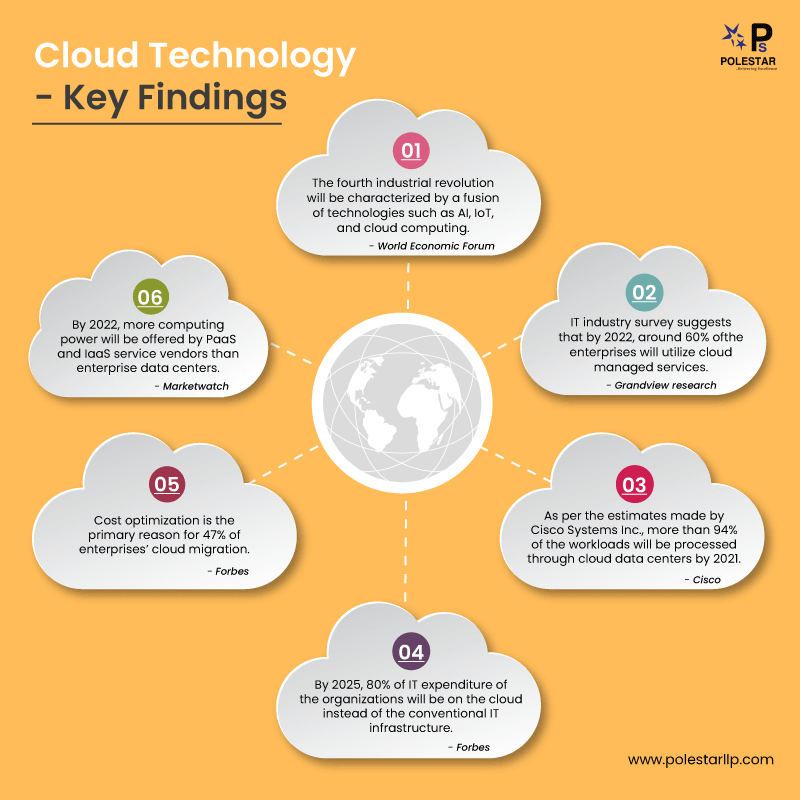
Sign up to receive latest insights & updates in technology, AI & data analytics, data science, & innovations from Polestar Analytics.
The rise of the cloud over the past few years has transformed business technology. From managing application development to tech infrastructure to remote work and beyond, cloud computing has become integral to day-to-day business operations.
As the cloud continues to grow, it will also continue to shape the world of business in new and exciting ways. Today, organizations across the globe are inclining towards the cloud technology and cloud platforms for - enhanced data management & security, cost-efficient services, ability to access distributed computing and storage facilities from anywhere, anytime.
In the present scenario, industries across the world are impacted by Covid-19. Let’s take a dig at what is happening around Cloud computing in COVID-19.
The recent outbreak of COVID-19, a pandemic declared by the World Health Organization, has gravely impacted the economies worldwide. Countries across the globe have been in lockdown, leading to suspended operations across industries not falling under the umbrella of essentials.
Economies have been put in an intentionally induced coma by the respective governments. And Employees across various industries especially have to work remotely to keep the businesses moving.
With the current crisis in place, cloud computing technology will enhance access to data services and improve the connectivity between people and businesses on a global scale.
Numerous companies, financial establishments, educational institutions, and global enterprises will be able to operate and provide support to their customers and users on a variety of mobile devices. And this will subsequently impact market growth.
The global serverless architecture market size will grow by USD 9.16 billion during 2019-2023 at CAGR close to 26%. Businesses are moving to the cloud for security and efficiency reasons. Going serverless ensures flexibility, scalability, and fast disaster recovery.
This will change the way applications are created, deployed and operated. This means that the role of DevOps and cloud solutions architects will grow in the coming time.
This is another important technological innovation that is expected to be widely used post- COVID-19. Edge computing will grow as organizations will bring computation and data storage closer to the devices where they are gathered to increase network performance, speed and security.
According to a survey, The global cloud computing market size was valued at USD 266.0 billion in 2019 and is expected to expand at a CAGR of 14.9% from 2020 to 2027. Factors such as growing digital transformation among industries, rising penetration of internet and mobile devices across the world, and an increase in consumption of big data are the primary drivers fostering the market growth.
The development of next-generation industrial solutions will be cloud enhanced and require a cloud platform to showcase their digital business capabilities.
The rise in adoption of Internet of Things (IoT), edge computing, 5G, use of real-time analytics enabled by Artificial Intelligence (AI) and Machine Learning (ML) is likely to boost the value of computing technology among organizations.
An essential aspect of the market is the growing adoption - of large enterprises as well as Small and Medium Enterprises (SMEs). With the increasing demand for on-demand and need-based services, cloud computing has helped SMEs to compete in a much larger business space.
Moreover, the pay per subscription-based model offered by the service providers has provided SMEs with the flexibility to grow to their full potential. Despite some market barriers, such as security concerns and legacy systems, the market is anticipated to maintain a high growth pace in the coming years.

If your business has two employees or more, then you should be making collaboration a top priority. Cloud computing makes collaboration an easy process. Team members can view and share information quickly and securely across a cloud-based platform. Some cloud-based services even provide collaborative social spaces to connect employees across the organization, therefore increasing interest and engagement.
Cloud computing offers mobile access to corporate data via devices and smartphones, which, considering over 2.6 billion smartphones are being used globally today, is a great way to ensure that no one is ever left out of the loop. Staff with busy schedules, or who live a long way away from the corporate office, can use this feature to keep instantly up to date with clients and co-workers.
Through the cloud, you can offer conveniently accessible information to sales staff who travel, freelance employees, or remote employees, for better work-life balance.
Growth is inevitable; as organizations grow, so do their operations. Buying servers or allocating server space solely using on-premise solutions is a thing of the past. Presently, cloud service providers like - Microsoft Azure can help with increasing your storage capacity, making sure that your data needs are met.
Cloud platform providers offer you added server space, charging you based on – time spent on the server and storage amount. Through this service, organizations can quickly scale their business applications and operations according to demand at a lower cost. Scaling up or down is affordable and flexible, as organizations pay for what they use.
For organizations with a large number of resources, there are a host of new applications that can benefit them immensely.
Another factor worth considering the cloud is its ability to lower costs. Organizations pay for their storage space, and the time spent online. There can be massive savings in terms of server rents and other associated structural costs. When it comes to traditional methods of server hosting,
IT teams have often needed plenty of workforces to maintain and update these servers. With the cloud, there is no need to use too many resources for this purpose as everything is taken care of by the cloud vendors. This translates to better savings for an organization as there are lower overhead and less workers necessary to maintain the server.
The responsibility of maintaining the cloud’s operations is handed over to the vendors, relieving the organizations of these responsibilities.
When it comes to the cloud, there is plenty of flexibility available to the employees of an organization that adopts cloud solutions to its fold. Employees deployed across the world have greater mobility and flexibility to access customer-based data, which was previously not possible due to geographical restrictions. Now, everything is available online via the cloud, eliminating the need to use hard copies of the data.
The cloud platform is helping organizations to meet their security demands. We live in a world where data security has become more critical than ever, especially at a time when data breaches are happening left and right. If we compare on-site servers and online servers, in that case, cloud servers will always emerge as the clear winners.
Cloud technology configures its services to meet a company’s needs, which is further enhanced with top security software and other tools to keep its data safe. All data is stored in a centralized location, which is protected and guarantee that there is a maximum amount of security protection for your online data.
HAVE A LOOK TO OUR FREE WEBINAR ANALYTICS DRIVEN CRISIS MANAGEMENT
About Author

Content Architect
The goal is to turn data into information, and information into insights.